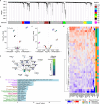Single-cell analyses identify monocyte gene expression profiles that influence HIV-1 reservoir size in acutely treated cohorts
- PMID: 40442100
- PMCID: PMC12122806
- DOI: 10.1038/s41467-025-59833-9
Single-cell analyses identify monocyte gene expression profiles that influence HIV-1 reservoir size in acutely treated cohorts
Abstract
Eliminating latent HIV-1 is a major goal of AIDS research but host factors determining the size of these reservoirs are poorly understood. Here, we investigate the role of host gene expression on HIV-1 reservoir size during suppressive antiretroviral therapy (ART). Peripheral blood cells of fourteen males initiating ART during acute infection and demonstrating effective viral suppression but varying magnitudes of total HIV-1 DNA were characterized by single-cell RNA sequencing. Differential expression analysis demonstrates increased CD14+ monocyte activity in participants having undetectable HIV-1 reservoirs, with IL1B expression inversely associating with reservoir size. This is validated in another cohort of 38 males comprised of different ancestry and HIV-1 subtypes, and with intact proviral DNA assay (IPDA®) measurements. Modeling interactions show monocyte IL1B expression associates inversely with reservoir size at higher frequencies of central memory CD4+ T cells, linking monocyte IL1B expression to cell types known to be reservoirs for persistent HIV-1. Functional analyses reveal that IL1B activates NF-κB, thereby promoting productive HIV-1 infection while simultaneously suppressing viral spread, suggesting a natural latency reversing activity to deplete the reservoir in ART-treated individuals. Altogether, scRNA-seq analyses reveal that monocyte IL1B expression could decrease HIV-1 proviral reservoirs in individuals initiating ART during acute infection.
© 2025. This is a U.S. Government work and not under copyright protection in the US; foreign copyright protection may apply.
Conflict of interest statement
Competing interests: The authors declare no competing interests.
Figures





Update of
-
Single-cell analyses reveal that monocyte gene expression profiles influence HIV-1 reservoir size in acutely treated cohorts.bioRxiv [Preprint]. 2024 Nov 15:2024.11.12.623270. doi: 10.1101/2024.11.12.623270. bioRxiv. 2024. Update in: Nat Commun. 2025 May 29;16(1):4975. doi: 10.1038/s41467-025-59833-9. PMID: 39605411 Free PMC article. Updated. Preprint.
References
-
- Richman, D. D. et al. The challenge of finding a cure for HIV infection. Science323, 1304–1307 (2009). - PubMed
-
- Finzi, D. et al. Identification of a reservoir for HIV-1 in patients on highly active antiretroviral therapy. Science278, 1295–1300 (1997). - PubMed
-
- Wong, J. K. et al. Recovery of replication-competent HIV despite prolonged suppression of plasma viremia. Science278, 1291–1295 (1997). - PubMed
MeSH terms
Substances
Grants and funding
- UM1 AI069494/AI/NIAID NIH HHS/United States
- U24 AI143502/AI/NIAID NIH HHS/United States
- UM1 AI164565/AI/NIAID NIH HHS/United States
- UM1 AI068618/AI/NIAID NIH HHS/United States
- AAI20052001/AI/NIAID NIH HHS/United States
- R15 AI172610/AI/NIAID NIH HHS/United States
- UM1 AI068636/AI/NIAID NIH HHS/United States
- UM1 AI126603/AI/NIAID NIH HHS/United States
- 5UM1AI126603-05/Division of Intramural Research, National Institute of Allergy and Infectious Diseases (Division of Intramural Research of the NIAID)
- P30 AI027757/AI/NIAID NIH HHS/United States
- UM1 AI106701/AI/NIAID NIH HHS/United States
LinkOut - more resources
Full Text Sources
Medical
Research Materials

